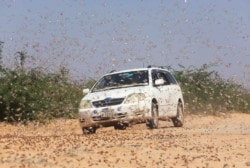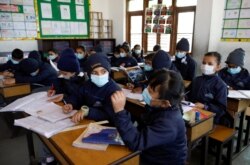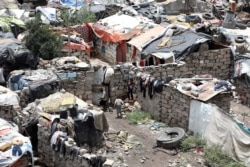As a child in Somalia, Mohamed Mohamud proudly tended to several dozen small tomato plants. He had seen his grandmother buying tomatoes daily at the market and figured his family could grow the plants themselves.
“That’s when the insects came in,” Mohamud recalled decades later. He is now an entomologist with the Nairobi-based International Center of Insect Physiology and Ecology, which works to alleviate poverty and food insecurity by developing ways to control crop-destroying insects.
“That’s when they started destroying the leaves,” Mohamud said. “If there is no leaf, there is no fruit. The leaf is the one producing food for the fruit to grow bigger.”
Locusts, coronavirus hurt food programs
Earlier this year, Somalia faced its worst invasion of desert locusts in a quarter century. The country declared a state of emergency in February over the swarms, which can grow to several hundred square kilometers, according to the United Nations Food and Agriculture Organization (FAO). Each square kilometer can contain 40 to 80 million locusts, which eat the same amount of food in one day as about 35,000 people.
But border closures due to the coronavirus are hampering the institute’s response to the crisis, which relies on equipment and people from abroad.
“When the locust swarms become too big in number, you expect the FAO headquarters to send some helicopters, some more biopesticide, at least more equipment, like vehicles,” said Mohamud. “With the COVID-19 and blockades everywhere, it has worsened the situation, because the movement, and all of the activity you could do, it has been made impossible.”
While border shutdowns block some equipment imports, internal lockdowns have also forced time-consuming and expensive programmatic changes in other countries.
Neera Sharma, who manages the World Food Program (WFP) school meal initiative in Nepal, recalled the grueling four-month process of transitioning the program to a take-home format during the pandemic.
The program developed new standard operating procedures based on World Health Organization (WHO) recommendations and national ministry directives, which then needed approval from both the Nepalese government and the U.S. Department of Agriculture, which helps fund the program.
“[In] May, June, July — three months — there was nothing,” said Sharma. “Specifically for the meals, we didn’t have any option at that time.”
Many schools, which closed during Nepal’s national lockdown, were temporarily converted to quarantine centers, complicating distribution efforts. The government’s focus earlier this year was on digital literacy — training teachers to give remote instruction and helping the government produce materials for the switch to online learning.
“There were countless children in Nepal who go to school on an empty stomach, making it hard for them to focus even before the pandemic,” Sharma said. When schools closed, 2.4 million children missed out on the lunches they relied on, according to the WFP.
While the virus has made difficult conditions worse in Somalia, Nepal and elsewhere, the situation may be grimmest in Yemen, site of what has been called the worst humanitarian crisis in the world.
“People in Yemen are still in need for the very basic things,” said Sonia Almassad, who manages two sub-offices in the U.N.’s Office for the Coordination of Humanitarian Affairs (OCHA). “[People] need water. They need food. They need health services. They need shelter, because we have a lot of displaced people. They need mattresses, blankets and so on.”
The rainy season is ongoing, displacing people in floods and causing spikes in cases of cholera and dengue fever. Yemen itself is in the middle of a disastrous civil war that began in 2015 and has contributed to a volatile security situation and extreme mass poverty.
“And then you put on top [of that] COVID-19,” said Almassad, “which makes things more difficult, much worse.”
Humanitarian responses to the crisis in Yemen have been delayed because operations take longer now and are more expensive. Distribution takes place over longer periods of time to enable physical distancing, and teams need personal protective equipment, which raises costs.
The OCHA and other U.N. agencies are struggling to find the means to continue operating in Yemen.
“Without funds, we can’t do anything,” Almassad said.
She is organizing it all from her home in Syria, where she has been working remotely since July. She spent over four months in an OCHA guest house in Hodeidah, Yemen, only able to move from room to room.
“You spend more time working, but [they are] not the same results you are hoping for,” Almassad said, describing the late work nights.
Humanitarian challenges
The task ahead of humanitarian workers is daunting.
In Somalia, Mohamud fears that heavy rains now will cause another wave of locusts. Already, the FAO expects that one in every four Somalis, or 3.5 million people, will face acute food insecurity by September.
In Yemen, three of Almassad’s U.N. colleagues recently died. The U.N. declined to say if COVID-19 was the cause. Still, she expects to return to the country in the next month.
“I know the needs are great, but I know that I can [provide] support,” she said. “Supporting people — it means a lot to me. I know what the meaning of suffering is because I lived it in my country, and so did my friends, my relatives, my people.”
In Nepal, Sharma appeared hopeful. The school meal program has a new set of standard operating procedures for take-home meals. The program distributed the first round in July and will continue distributing the 1,500 metric tons of food donated by the U.S. in a second round set for late September.
The program has done so well that in this year’s national budget, the Nepalese government agreed to expand its coverage from 60% to 100% of the country. The government will spend $76 million to provide meals in 70 districts, said Sharma, while the WFP in Nepal will continue supplying food to the other seven.
“When the family and the children receive this oil, fortified rice, lentils — to see that smile on the child’s face … and knowing that a child won’t go to bed tonight with an empty stomach because of [this] program, that’s extremely rewarding,” she said. “I feel so proud to be a part of this.”
The U.N.’s World Humanitarian Day is Aug. 19. It was formalized in 2009, six years after a hotel bombing in Baghdad on Aug. 19 killed 22 people.
In 2019 alone, nearly 500 aid workers were wounded, kidnapped or killed, according to the U.N. That same year, the World Health Organization reported more than 1,000 attacks against health care workers and facilities, killing 199 and injuring more than 600.
Despite the dangers presented by COVID-19, conflict and climate, the U.N. said it had aid workers in 63 countries under its Global Humanitarian Response Plan.














